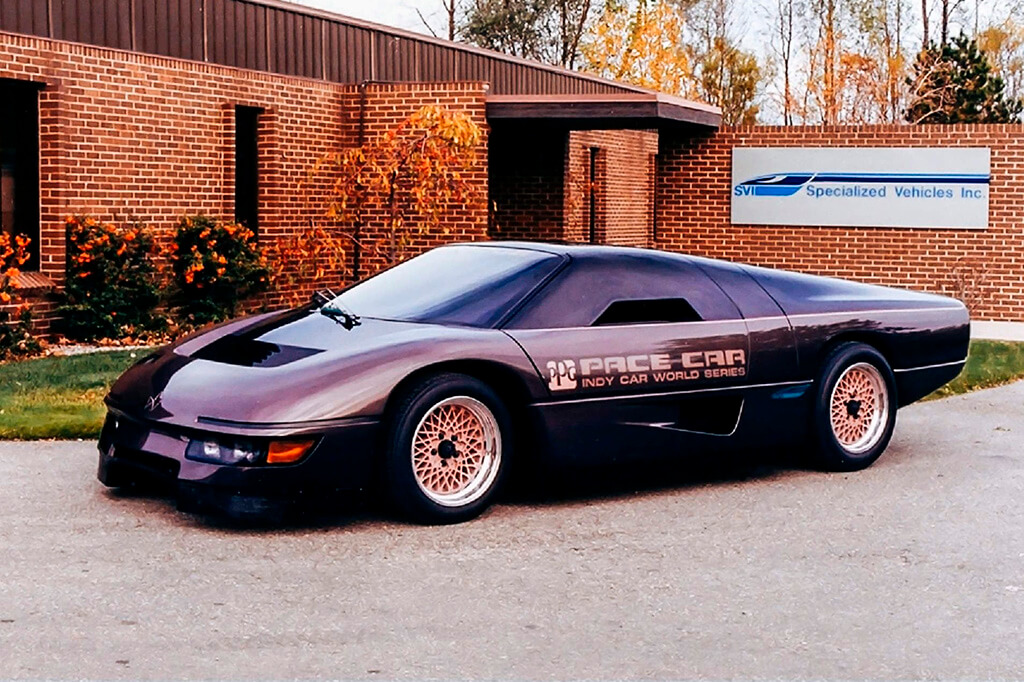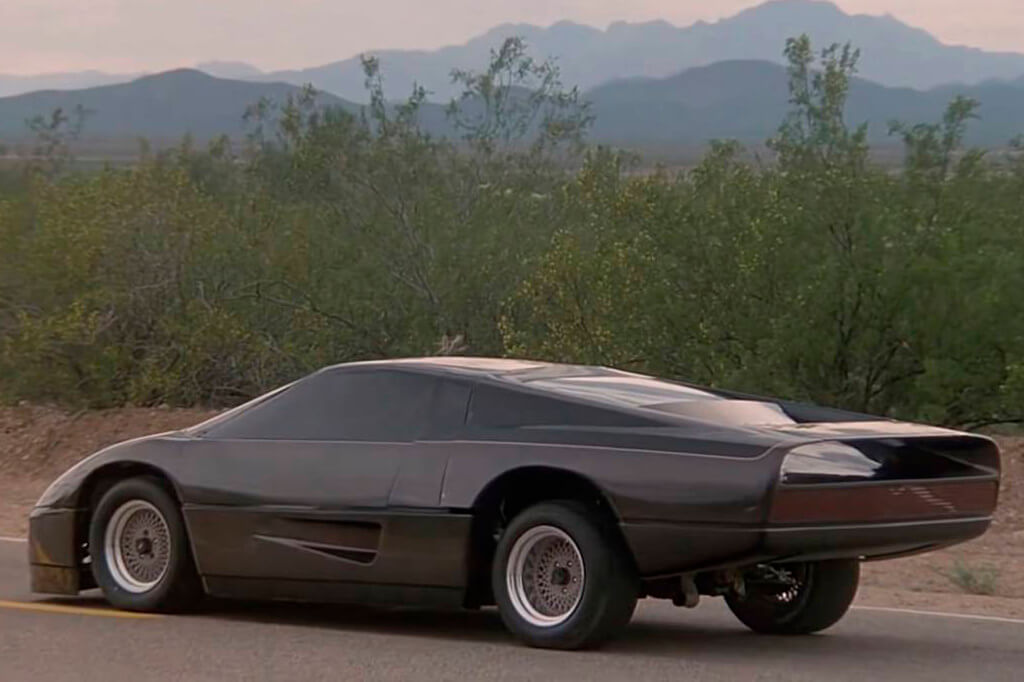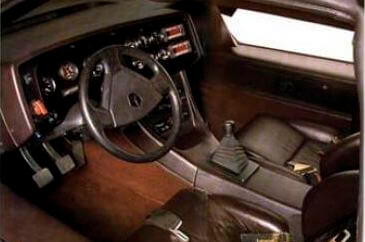Dodge M4S Turbo Interceptor Pace Car Concept
Description
The Dodge M4S (Dodge PPG Turbo Interceptor) is a mid-engined concept car introduced in 1984. The car was supposed to be a pace car, but was not put into production due to the high cost. The name M4S stood for "Mid-engine 4-cylinder Sport" – mid-engine, 4-cylinder, sporty.
The history of the concept began on June 13, 1983 with a meeting between representatives of Chrysler and PPG (until 1968 – Pittsburg Plate Glass Company – a Pittsburgh company that produced glass, paint, fiberglass and various chemicals, and since 1975 supplied paint for racing cars). Dodge has previously supplied cars to PPG – Mirada, Charger and Daytona, but retaining their standard appearance or at least a semblance of recognition. The new pace car project was assigned to Bob Ackerman of Chrysler's product design department. “The approach I took for this car was to build more of a racing car than a pace car. I was inspired by IMSA designs, like the Porsche 962. And I wanted to reach a speed of 320 kph,” Bob himself described his vision.
The first problem was the chassis - Chrysler did not have a ready-made design suitable for Ackerman's needs, and the budget for the pace car did not include creating such a chassis from scratch. Luckily, Bob read an article in Sports Car Graphic magazine about a Pontiac Fiero-style racing car designed by California-based Joe Huffucker. Chrysler engineers have confirmed that their 2.2-liter 4-cylinder engine can be installed in the Huffaker chassis without any problems, and PPG approved the purchase, as they have already dealt with this company.
Ackerman entrusted the main work on the development and assembly of the car to the independent company Specialized Vehicles Inc (SVI) from Troy, Michigan, which was founded by former Chrysler employees Mike Koran and Tom Coddington. The company previously worked with Dodge on the 1978-79 Lil' Red Express Truck pickup and a previous PPG pace car project based on the Dodge Charger. Joe Hoffaker shipped them the ordered chassis in two halves, as Ackerman wanted to lengthen the wheelbase from 2375 mm to 2548 mm, and SVI welded them to that plan. The creation of a power unit based on a serial 2.2-liter block was also entrusted to SVI. Koran and Coddington fitted it with a Cosworth 16-valve cylinder head (a few years before Dodge's stock 2.2 DOHC!), Bosch electronic fuel injection, dry sump lubrication, and best of all, twin Garrett T25 turbos with intercoolers. . As a result, 440 hp were removed from 2.2 liters. at a boost pressure of 1.7 bar. Unfortunately, this motor was placed transversely in the chassis, following the logic of serial Dodge from 2.2, and this sharply limited the choice of transmission. Had the engineers initially heeded designer Ackermann's proposal for a longitudinal motor setup, it could have been paired with a real Hewland or ZF racing gearbox, which offer nearly the widest range of gear ratios to tune to a particular race track.
In parallel, the development of the body was underway. Based on Ackerman's sketches, a full scale foam and clay mock-up was made by 3D Industries Inc. It was then digitized and turned into body drawings by Chrysler's computer modeling team, with interesting features such as Lamborghini Countach-style liftgates, movable spoilers, and a 73-degree windshield. In order to save money, the windshield was borrowed from the Ferrari Berlinetta Boxer, and the rear from the Datsun 240Z.
The resulting layout was blown in the Lockheed wind tunnel in Atlanta in February 1984, but initially received unsatisfactory 0.268 Cd. Then SVI employees produced new aluminum panels right on the spot, and after 17 hours of work, the aerodynamic drag coefficient was reduced to 0.236 Cd! At the same time, the unacceptable rear lift was also overcome, reducing it from 150 kg to zero. By the way, active spoilers had to be abandoned: the Chrysler aerodynamics team was very inspired by this idea, but could not put it into practice in the available budget.
During races on the 28-kilometer oval track of the Center for Transportation Research in Marysville, Ohio, Indy 500 driver Graham McRae reached a speed of 313.6 kph in a Dodge M4S, thereby coming close to Ackerman's goal of reaching 320 kph ( 200 mph). Acceleration to 60 mph was at the level of 4.1 seconds, and the time of passing 1/4 mile from a standstill was 12.9 seconds. The blame for the fact that the cherished "200 mph" did not submit to the car, Ackerman placed on the transmission, suggesting that with the replacement of gear ratios, 340 kph could also be reached, which would have a positive effect on the public image of the car.
The final assembly of the car, which was commissioned to Special Projects Inc of Plymouth, Michigan, included fabrication of the interior with leather Recaro seats and Stewart-Wagner appliances, as well as the installation of an air conditioner. However, the M4S did not expect comfort: inside it was more like racing cars, and getting in and out was a certain difficulty, for example, for a person in a business suit.
Of course, the car was painted with PPG Deltron materials: mother-of-pearl bronze over a black base coat, plus five coats of lacquer. The color combination was chosen by PPG themselves and, according to Bob Ackerman, the decision was made by a woman. This backfired when the finished car was demonstrated to the head of Chrysler, Lee Iacocca. He remarked as he smoked a cigar: “Damn me! Nearly 200 mph and pink rims!” But, apparently, PPG, when choosing a color, was guided only by considerations of demonstrating the capabilities of their paints ...
The first show of new items took place at the Detroit Auto Show in January 1986. Immediately after this (that is, even before the Dodge M4S began to serve its intended purpose as a pace car of the PPG/CART series), Chrysler marketers managed to attach it to the movies. Moreover, Bob Ackerman was against it, arguing that “this is a full-fledged car, and Hollywood knows how to make some kind of laughingstock out of cars, as it was with Lincoln Futura. I don't want the M4S to become another Batmobile." However, the project cost Chrysler and PPG about $1,500,000, and leasing it to filmmakers could reduce that amount a bit.
For the filming of the film "Spirit of Vengeance" Dodge M4S in February 1986 was transported to Arizona. At the same time, the company of the famous designer Gene Winfield, using the original Chrysler matrices, produced 6 copies of the M4S bodies, of course, without any racing “stuffing”: four models and two driving samples with frames of ordinary beach buggies on VW Beetle units. Since "lambo doors" were difficult to reproduce, replicas instead had a gullwing mechanism.
Of the six replicas that were filmed, only two survived to the end of the process. The fate of the first is unknown and may have been destroyed after filming. The second was taken back by Gene Winfield. It was later bought by California exotic car dealer Bob Butts and resold in Cleveland to Corvette tuner John Watson. He seriously intended to use his company Air Dynamics to start a limited production of M4S replicas with Corvette units, a Buick V6 compressor engine and a FabCar chassis, and it was not supposed to be a kit car, but a finished Wraith II car with a price of over $100,000 at the end. 1980s But these plans were not destined to come true. But at least the replica itself from the film has been preserved.
She first went to McPherson College in Kansas, known for its auto restoration program, which is supported by, for example, Jay Leno. While the car was waiting to be restored, it was discovered by Vengeance film enthusiast Lyle Sur, who was able to buy it back for himself and restore it by 2010, and later even replace the Buick engine installed before it with a suitable Dodge 2.2-liter turbo engine.
Sources
Specification
| Bodywork | |
|---|---|
| Presentation | |
| Years of production |
1981-1984
|
| Produced (pcs.) |
2
|
| Body type |
купе
|
| Number of doors |
2
|
| Number of places |
2
|
| Engine | |
|---|---|
| Engine type |
бензиновый
|
| Engine location |
центральное, поперечное
|
| Engine model |
Chrysler
|
| Cylinders |
R4
|
| Capacity (cc) |
2198
|
| Power output (hp / kW /) |
446 /
328 /
|
| at rpm |
7000
|
| Torque (N·m) |
300
|
| Bore (mm) |
87,5
|
| Stroke (mm) |
92,0
|
| Number of valves |
4/16
|
| Valvetrain |
DOHC
|
| Dry sump |
да
|
| Fuel system |
впрыск
|
| Fuel system model |
Bosch L-Jetronic
|
| Turbocharger |
2
|
| Compressor model |
Garret T-25
|
| Turbo pressure (bar) |
1,7
|
| Specific | |
|---|---|
| Specific output (hp/litre) |
202,91
|
| Specific output (hp/tonne) |
385,48
|
| Specific output (kg/hp) |
2,59
|
| Specific torque (N·m/litre) |
136,49
|
| Specific torque (N·m/tonne) |
259,29
|
| Transmission | |
|---|---|
| Driven wheels |
задний
|
| Gearbox |
механическая
|
| Number of speeds |
5
|
| Suspension | |
|---|---|
| Front suspension |
независимая
|
| Rear suspension |
независимая
|
| Elastic elements in front |
пружины
|
| Elastic elements in rear |
пружины
|
| Wheels brand |
BBS
|
| Wheel size front |
9J×16
|
| Wheel size rear |
9J×16
|
| Steering | |
|---|---|
| Steering type |
шестерня-рейка
|
| Brakes specs | |
|---|---|
| Brakes front |
дисковые вентилируемые
|
| Brakes rear |
дисковые вентилируемые
|
| Disc material |
чугун
|
| Dimensions and weight | |
|---|---|
| Body |
стальной трубчатый каркас
|
| Body material |
стекловолокно
|
| Length (mm) |
4720
|
| Width (mm) |
1820
|
| Height (mm) |
1100
|
| Wheelbase (mm) |
2540
|
| Drag coefficien |
0,236
|
| Curb weight (kg) |
1157
|
| Weight distribution (%) |
50/50
|
| Performance specs | |
|---|---|
| Fuel type |
бензин
|
| Dynamic specs | |
|---|---|
| Acceleration 0-100 kph (s) |
4,3
|
| Acceleration 0-60 mph (s) |
4,1
|
|---|
| Acceleration 0-402 m (1/4 mile) (s) /kph/ |
12,9 /
167,0 /
|
|---|
| Top speed (kph) |
314
|
|---|---|
| Top speed (mph) |
195
|
| Tags: | |
|---|---|
| Type: | |
| Brand: | |
| Country: |



